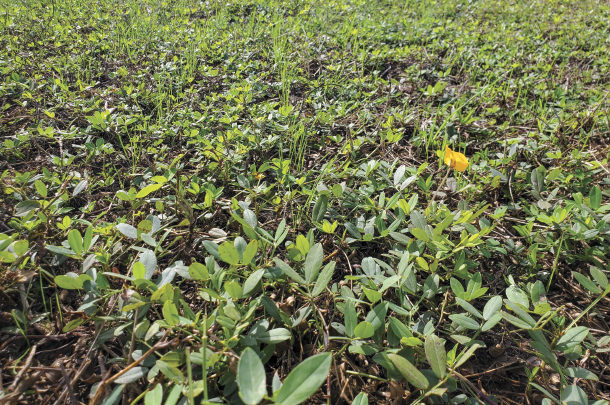Often referred to as “the alfalfa of the South,” the addition of perennial peanut into forage systems has been a game-changer for many Florida cattlemen looking to improve their ranch’s performance. These integrated grass and legume mixtures aren’t just for Florida producers, though – they can provide benefits to cattle producers across the Deep South, namely reduced nitrogen fertilizer applications, increased cattle performance and ultimately a reduction in total production costs. However, any new technology or growing method, no matter how beneficial, comes with some hesitation from producers, particularly when first adopting and integrating perennial peanut into conventional grass pastures.
While integrating the alfalfa of the South into traditional warm-season pastures isn’t without other challenges (weed control and fertility programs become somewhat more complicated, for instance), the primary main concern first-time growers of perennial peanut/grass mixtures often have is a lack of information regarding overseeding cool-season forages into the dormant grass/legume systems.
Producers in the coastal South rely on their pastures to feed cattle year-round – and summer forages, even high-quality species like perennial peanut, are only as good as their ability to allow cool-season forages to be drilled in for winter grazing. Only recently has there been much information to share regarding this topic. The following is a rundown of a couple of the most frequently asked questions I get regarding overseeding cool-season forages into perennial peanut pastures, along with some answers.
1. Will winter overseeding hurt my perennial peanut regrowth in the spring?
The classic “it depends” answer applies here. Any effect on perennial peanut spring regrowth depends almost solely on the type of cool-season forage chosen by the producer. Small grains, such as cereal rye, oats and wheat, planted at recommended rates after frost (when perennial peanut typically goes into dormancy) almost certainly will not affect perennial peanut that fall. As long as the winter forage is grazed or harvested by early spring greenup, it will not likely harm perennial peanut summer yields either.
On the other hand, annual ryegrass tends to be later-maturing and, if not removed by mid-March, there might be some modest yield delay in early summer due to direct competition for resources, particularly light and water.
Note: In years where dry winters are predicted, utilizing cereal rye and/or triticale in place of or in addition to oats or wheat may provide some protection against drought impacts.
Clovers can also be overseeded on dormant perennial peanut, but they are best mixed with small grains rather than planted alone. Crimson clover is an early maturing option, while red, ball and berseem clovers can continue producing low amounts of forage into the early summer. With that in mind, you might want to avoid the later-season clovers for a perennial peanut hayfield, but it should be fine to use in a mixed pasture.
Note: If a forage mix containing annual ryegrass or later-maturing clover species is used, producers should be diligent about grazing it down heavily in spring to reduce negative impacts on perennial peanut regrowth.
2. Does the perennial peanut provide any fertility to my cool-season forages?
The short answer is: probably not much. In conversations with Dr. Cheryl Mackowiak, associate professor of soil and water sciences at the UF/IFAS NFREC, she indicated that, while perennial peanut’s nitrogen-fixing nature delivers clear and known fertility benefits to its summer grass companion, she found little of that nitrogen (N) was available to provide all the nitrogen needs of the cool-season forage. She recommends applying a standard N rate of 30 to 50 pounds per acre per season, along with at least 30 pounds K2O and 10 pounds sulfur per acre, unless ammonium sulfate is used as the N source.
If you’ve already integrated perennial peanut into your grass pastures or have been thinking about it, hopefully these tips will help answer potential questions and dispel concerns you may have had regarding your cool-season grazing plan.
If you have any further questions on this or other agronomic topics, please contact your local land-grant university extension office.
Thanks to the work of the University of Florida (UF) and Institute of Florida Ag Sciences (IFAS), forage agronomy specialists Dr. Jose Dubeux, Dr. Ann Blount (and others at the NFREC – Marianna) and many Florida cattlemen.
References omitted but are available upon request by sending an email to the editor.












